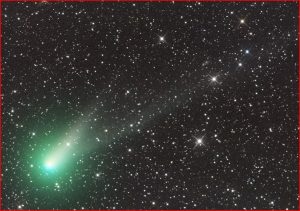 2015 set off to a great start for comets with Comet Lovejoy (C/2014 Q2) gracing the skies of the Northern hemisphere at naked eye visibility through the winter months. Discovered by Terry Lovejoy who has already got a reputation for discovering bright comets, this was no exception as it climbed higher and higher in to the Northern night sky while still remaining within naked or binocular view. It was quite a show for both photographers and observers alike.
2015 set off to a great start for comets with Comet Lovejoy (C/2014 Q2) gracing the skies of the Northern hemisphere at naked eye visibility through the winter months. Discovered by Terry Lovejoy who has already got a reputation for discovering bright comets, this was no exception as it climbed higher and higher in to the Northern night sky while still remaining within naked or binocular view. It was quite a show for both photographers and observers alike.
So what’s next for 2015? Are there any more naked eye comets on the horizon? Below are just a few comets visible in 2015 which have caused a bit of a stir…
Comet C/2013 US10 Catalina
Discovered in the Autumn of 2013 by the Catalina Sky Survey, this comet has been residing in the Southern hemisphere as a circumpolar object from July through to August reaching magnitude 7. In September, the comet has almost reached naked eye visibility and will now surge toward perihelion on November 15th. Northern sky observers don’t despair, your time has come! Latest observations predict that after perihelion, the comet heads North and is expected to reach magnitude 5 which brings the comet within naked eye visibility. Fingers crossed that these predictions come true. On new year’s eve 2015, the comet brushes past bright star Arcturus. More…
Comet 67P/Churyumov-Gerasimenko
Discovered by Soviet astronomers Klim Ivanovych Churyumov and Svetlana Ivanovna back in 1969 using photographic plates, the comet’s name is quite a tongue twister. Many like to just call it 67P to make things easier! This comet has had plenty of media attention being at the centre of the already successful Rosetta Mission to send a spacecraft to land on the comet. After the many incredible high resolution images beamed back from Rosetta, this summer, amateur astronomers had the chance to observe this comet through their own backyard telescopes. The comet reached perihelion on August 13th then became a morning object shortly thereafter in the constellation of Gemini. The comet is now fading beyond visual magnitude 12.
Comet C/2014 Q1 Panstarrs
Yet another discovery by the Panoramic Survey Telescope & Rapid Response System (Panstarrs) in August 2014, you have to be careful to ensure you have the right comet number as Panstarrs have stacked up quite a plethora of comet discoveries since its launch in 2010. Gone are the days of relying on discoverers names! It was best seen through July and August from the Southern hemisphere (again), C/2014 Panstarrs reached perihelion on July 6th, 2015 after a close brush with the sun. So close that it reached up to magnitude 4.5. An easy naked eye target.
Comet 88p Howell
This comet was originally discovered in 1981 in the 0.46-m Schmidt telescope at the Palomar Observatory in Southern California. It Reached perihelion on April 6th at magnitude 8 making it an easy small telescope target. Unfortunately this comet was for Southern hemisphere observers only during April and May 2015.


Leave a Reply